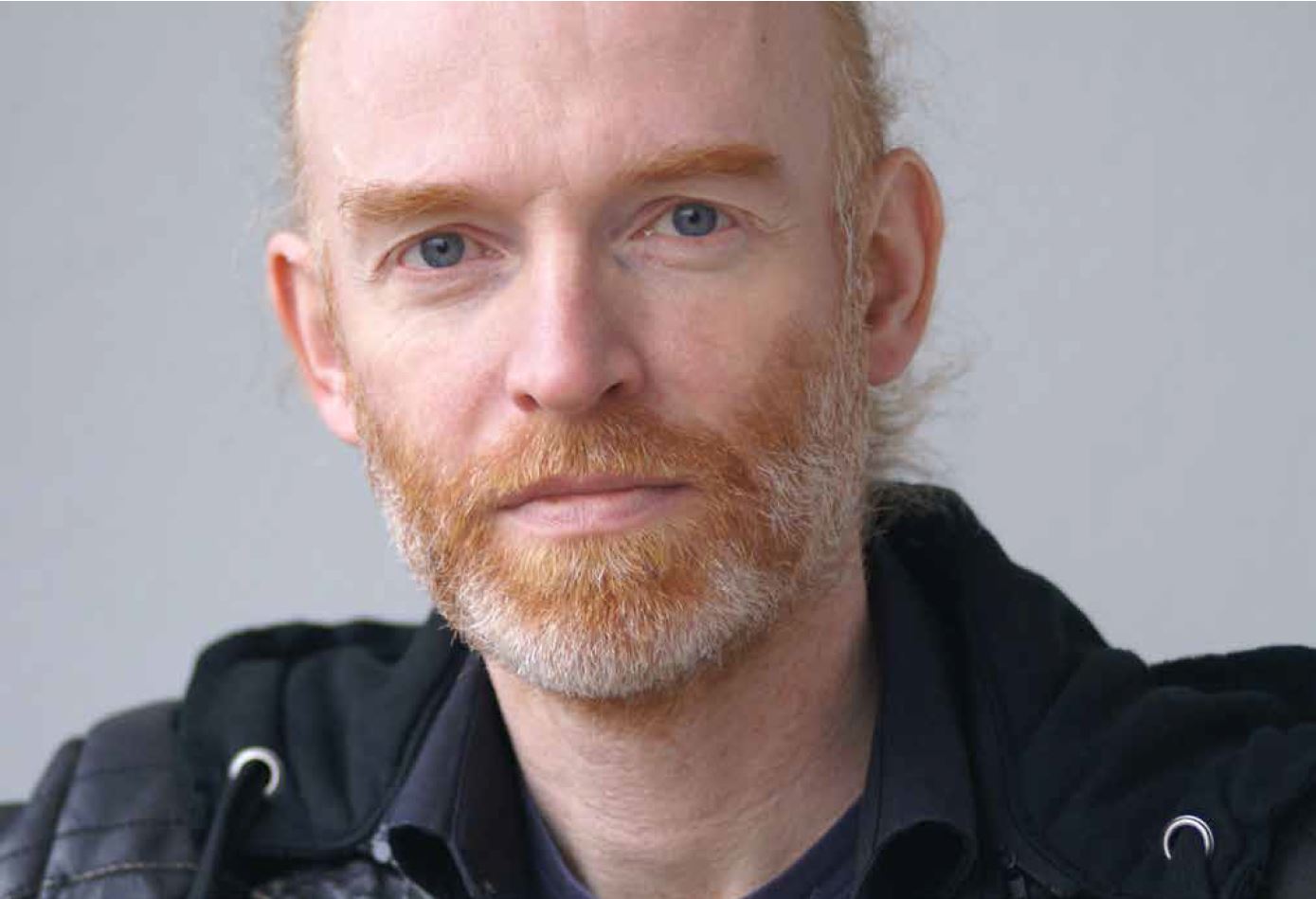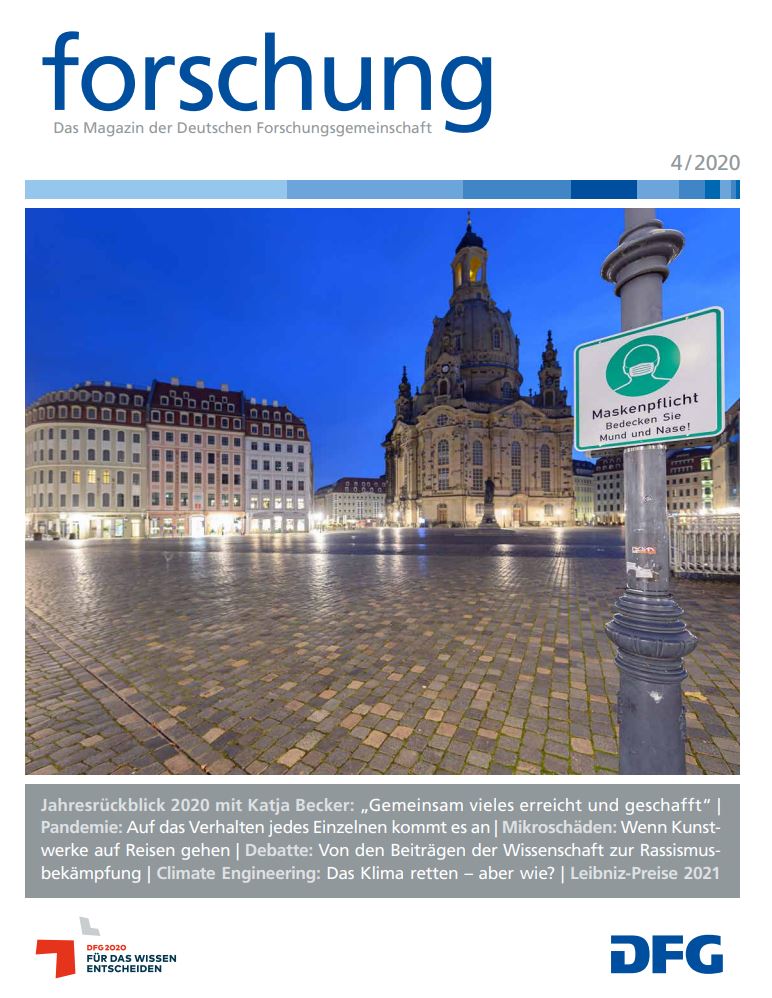“The behaviour of each individual matters”

Prof. Dr. Michael Meyer-Hermann
© anna.lachaque
Physicist, infection researcher, pandemic modeller: Michael Meyer-Hermann relies on data- driven methods for understanding the course of the COVID-19 crisis. His expertise is highly appreciated by policy makers, the media and the field of basic research. We spoke to the pioneering researcher who is part of the DFG’s interdisciplinary Commission for Pandemic Research.
Interview: Dr. Rembert Unterstell, german research.
german research: Professor Meyer-Hermann, we are having this conversation in mid-December, following the decision to have a second rigorous lockdown amid the second wave of the pandemic. In which way does the cur-rent situation differ from the first hard lockdown back in spring?
Michael Meyer-Hermann: Case numbers are much higher than in spring, as we all know. The population no longer took the virus quite as seriously, after having overcome the first wave. The weather in summer was an adverse factor. We are now in a situation where we can no longer rule out that a triage may become necessary in overburdened hospitals. It was therefore urgently necessary to take strong measures.
The second rigorous lockdown appears to be clear evidence that the “wave breaker lockdown” implemented in early November has failed. Do you share this view?
Case numbers were stabilised through the soft lockdown and public awareness of the issue was raised once again. So it was not in vain. However, the exponential growth that is currently taking place, shows that these softer measures did indeed not suffice to regain control of the pandemic. It is regrettable that we waited for so long, before implementing a hard lockdown. Back in October, the same measures could have swiftly nipped the second wave in the bud, and have saved many lives, as well as reducing economic and psychosocial consequences.
Will the current, tightened restrictions be enough to control and restrict the spread of the infection?
The measures are not as drastic as they may seem. Schools would soon have closed anyway. The most significant additional measure taken is to close shops. This is certainly going to prevent a lot of contact in the context of Christmas shopping. On the other hand, there will be additional contacts due to family visits over Christmas. The school closures which are intended as a pre-quarantine, will hopefully help to limit the number of new infections among the elderly. In our models we assume an increase of cases ten days after Christmas, along with an overall downward trend. However, these models are based on constant case numbers. We cannot tell for certain, whether this will be enough considering the exponential growth we are currently experiencing as a starting point. We must be very careful!
Every day, we are presented various key figures related to the pandemic. Among these are the numbers of new infections, of available intensive care beds and of deaths due to COVID-19. You frequently stress the importance of the R value. Why is it so significant?
The R value allows for a look into the future. The R value indicates the trend of the development. It has meanwhile become common knowledge that the R value must be lower than 1 for case numbers to decline. It is a quick indicator that shows, whether additional action is required to fight the pandemic.
Another indicator is the 7-day incidence rate. Do you still think that a threshold value of 50 cases per 100,000 people is suitable for determining where restrictions can be eased and where they must be tightened?
I have been urging strongly that this figure should not be subject to debate. Policy makers have demonstrated a good sense of intuition in choosing this figure. The value reflects the goal that health offices should remain capable of tracking contacts and documenting infection chains. An incidence rate of 50 is just about manageable for the health authorities. However, it is also the tipping point between controlled growth and an unrestricted development that can easily become exponential in its full dynamic.
Can this approach be used in a hotspot strategy?
A hotspot strategy is not relevant at this point, as we are in the middle of a situation that resembles a largescale blaze. Hotspots will only become visible and relevant after this wildfire has been extinguished. Only then can they be addressed through local and regional measures.
Physical distancing, handwashing, non-medical face masks – setting these rules is one thing, their acceptance and the behaviour of people is different story. Do you think that it is even possible to overestimate this factor?
Public acceptance is indeed the decisive critical factor. Our modelling activities have shown changes in the population’s contact behaviour even before the start of the actual measures, both in the case of the full lockdown in spring and of the partial lockdown in autumn. This is very clear and it shows the power that lies within the behaviour of the general public. Debate of the lockdown made many people real-ise that the situation is serious and that action is required.
At the state premier conference regarding the coronavirus situation that was held at the Federal Chancellery in mid-October, you issued urgent warnings based on figures and graphs, saying that we are not approaching a crisis but right in the middle of it. The media even referred to you as the “Merkel Whisperer”. How do you understand your role in policy consultation?
My role as a researcher is to provide simulations that act as a data-base for political decisions; to offer a prospective view of the situation and the development trend. However, I always point out that our forecasts cannot cover a period of more than two to four weeks. One reason for this is that the behaviour of the population adapts to the respective situation within the pandemic. This is why the forecasts should not be overinterpreted: I use data of the pandemic and assess it, and I try to tell which way the situation is headed in different scenarios. This allows me to illustrate the effect of particular measures. It is the job of policy makers to consider these assessments in relation to other issues, such as ethical, social or economic aspects. In my research, however, I have been increasingly focusing on these border regions between the different disciplines. This gave rise to the paper “Shared interests of public health and the economy” by the ifo Institute and the HZI, in which we point out that swift control of the pandemic is vital to allow for a healthy economy and that political containment measures are therefore justified.
Let us talk about your public impact for a moment: In April you coauthored a widely acclaimed analysis of the dy-namics of the pandemic issued by the Helmholtz Association. Since June, you have also been a member of the DFG’s Commission for Pandemic Re-search. What are your expectations in this context?
The interdisciplinary nature of the commission is a very important factor to me. I find this very rewarding and it is beneficial to decision-making processes and recommendations. One’s own perspective is complemented by those of others, especial in the area of basic research. This also allows for an easier implementation of decisions, as other aspects such as behavioural psychology during the pandemic, or legal and economic collateral damage are also taken into account. More to the point: We focus not only on intensive care bed availability, but on a broad understanding of pandemic activity. This is very important and worthwhile in my opinion. Beyond calls and funding for basic research projects, the pandemic commission could also set a trend for communication with the public and the provision of clear information about the pandemic.
Speaking of trends and in the context of your discipline, the field of systems immunology: Is my impression correct that even before the pandemic, you advocated the view that in the methodological canon of immunological research, greater importance should be attached to approaches from the areas of physics and mathematical modelling?
Your impression is very accurate. I have been campaigning for a long time for methods from mathemat-ics to become part of the standard repertoire of immunology. My simulations are examples of how this might work, and of how the results can be used in a constructive manner, not only during a pandemic.
Before we come to the end of this conversation, we must talk about the promising prospects of COVID-19 vaccines. Which impact do you expect vaccination campaigns will have on the further course of the pandemic?
First we will have to wait and see how effective the announced vaccines really are, especially taking different age groups into account. I am thinking about senior citizens aged 60 and up in particular, who are an especially vulnerable group for which the success rate of other vaccines is known to be significantly reduced. It is to be expected that sufficient time and quantities of vaccine will be needed to vaccinate the population at large. Even if a vaccine is highly effective and has few side effects, it will take a while to immunise all those willing to be vaccinated. A vaccine will reduce the problem of the pandemic, but it will not solve it.
Will we still be able to return to our old normality in 2021?
I hope that we will get the pandemic sufficiently under control to allow for normal social interaction without infecting others or getting infected. However, I do not believe that we will achieve this by spring. Maybe we will feel a form of relief by autumn 2021. Nevertheless, I also believe that we will have to face a new form of public culture that is based more strongly on mindfulness and consideration for others. Such a development could be beneficial not only to social interaction, but it may also encourage individual regulation in everyday life. Otherwise, the state will need to keep issuing social distancing orders again and again. The way in which people behave in their different areas of life will continue to be a key aspect of the pandemic.
Thank you very much for taking the time for this interview!
Further Information

The interview was published in the
English version of the interview is available in the